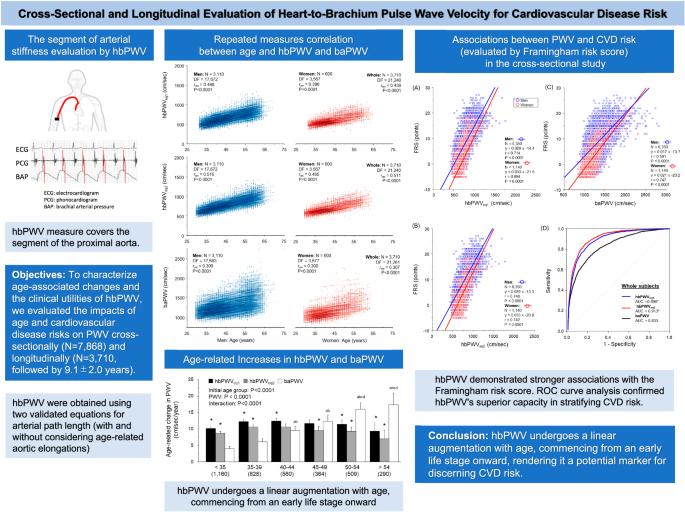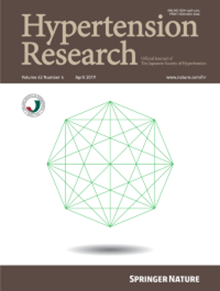Cross-sectional and longitudinal evaluation of heart-to-brachium pulse wave velocity for cardiovascular disease risk
IF 4.3
2区 医学
Q1 PERIPHERAL VASCULAR DISEASE
引用次数: 0
Abstract
Heart-brachium pulse wave velocity (hbPWV) is a promising measure of arterial stiffness including the proximal aorta. To characterize age-associated changes and the clinical utilities of hbPWV, we evaluated the impacts of age and cardiovascular disease (CVD) risks on hbPWV cross-sectionally (N = 7868) and longitudinally (N = 3710, followed by 9.1 ± 2.0 years). hbPWV were obtained using two validated equations for arterial path length (with and without considering age-related aortic elongations). Brachial-ankle pulse wave velocity (baPWV) was used as a comparative measure. Repeated-measures correlation (rmcorr) and regression analyses were used to characterize associations of PWVs with age and Framingham’s general CVD risk score (FRS). In the cross-sectional study, hbPWVs derived by both equations showed stronger correlation with age (r = 0.746 ~ 0.796) and FRS (r = 0.714–0.749) than baPWV (r = 0.554 and r = 0.643). Furthermore, hbPWVs correlated with FRS even after controlling for age (r = 0.260 ~ 0.269, P < 0.0001). In the longitudinal study, hbPWVs demonstrated significantly higher rmcorr coefficient with age than baPWV (rrm=0.439–0.511 vs. 0.307, P < 0.0001). Across the adult lifespan, age-related increases in hbPWVs were almost consistent, starting from young adults, while baPWV displayed accelerated increases with age. A receiver operating characteristic curve analysis indicated that hbPWVs depicted more robust ability to stratify general CVD risk compared with baPWV (AUC = 0.896–0.913 vs. 0.833, P < 0.0001). The results of the follow-up study were consistent with the findings of the cross-sectional investigation. Our findings suggest that hbPWV undergoes a linear augmentation with age, commencing from an early adult life stage onward, rendering it a potential marker for discerning CVD risk.


横向和纵向评估心肱骨脉搏波速度对心血管疾病风险的影响。
心肱骨脉搏波速度(hbPWV)是测量包括近端主动脉在内的动脉僵化程度的有效方法。为了描述与年龄相关的变化以及 hbPWV 的临床实用性,我们对年龄和心血管疾病(CVD)风险对 hbPWV 的影响进行了横向(N = 7868)和纵向(N = 3710,随访 9.1 ± 2.0 年)评估。肱踝关节脉搏波速度(baPWV)用作比较测量。重复测量相关性(rmcorr)和回归分析用于描述脉搏波速度与年龄和弗雷明汉一般心血管疾病风险评分(FRS)之间的关系。在横断面研究中,两种方程得出的 hbPWV 与年龄(r = 0.746 ~ 0.796)和 FRS(r = 0.714-0.749)的相关性强于 baPWV(r = 0.554 和 r = 0.643)。此外,即使在控制年龄后,hbPWVs 仍与 FRS 相关(r = 0.260 ~ 0.269,P rm=0.439-0.511 vs. 0.307,P
本文章由计算机程序翻译,如有差异,请以英文原文为准。
求助全文
约1分钟内获得全文
求助全文
来源期刊

Hypertension Research
医学-外周血管病
CiteScore
7.40
自引率
16.70%
发文量
249
审稿时长
3-8 weeks
期刊介绍:
Hypertension Research is the official publication of the Japanese Society of Hypertension. The journal publishes papers reporting original clinical and experimental research that contribute to the advancement of knowledge in the field of hypertension and related cardiovascular diseases. The journal publishes Review Articles, Articles, Correspondence and Comments.
 求助内容:
求助内容: 应助结果提醒方式:
应助结果提醒方式:


